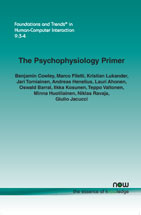The Psychophysiology Primer: A Guide to Methods and a Broad Review with a Focus on Human–Computer Interaction
By Benjamin Cowley, Finnish Institute of Occupational Health and University of Helsinki, Finland, Benjamin.Cowley@ttl.fi | Marco Filetti, HIIT, Aalto University, Finland, marco.filetti@hiit.fi | Kristian Lukander, Finnish Institute of Occupational Health, Finland, Kristian.Lukander@ttl.fi | Jari Torniainen, Finnish Institute of Occupational Health, Finland, Jari.Torniainen@ttl.fi | Andreas Henelius, Finnish Institute of Occupational Health, Finland, Andreas.Henelius@ttl.fi | Lauri Ahonen, Finnish Institute of Occupational Health, Finland, Lauri.Ahonen@ttl.fi | Oswald Barral, HIIT, University of Helsinki, Finland, oswald.barral@hiit.fi | Ilkka Kosunen, HIIT, University of Helsinki, Finland, ilkka.kosunen@hiit.fi | Teppo Valtonen, Finnish Institute of Occupational Health, Finland | Minna Huotilainen, Finnish Institute of Occupational Health, Finland, minna.huotilainen@helsinki.fi | Niklas Ravaja, University of Helsinki and HIIT, Aalto University, Finland, niklas.ravaja@aalto.fi | Giulio Jacucci, HIIT, University of Helsinki and HIIT, Aalto University, Finland, giulio.jacucci@helsinki.fi
Abstract
Digital monitoring of physiological signals can allow computer systems to adapt unobtrusively to users, so as to enhance personalised ‘smart’ interactions. In recent years, physiological computing has grown as a research field, and it is increasingly considered in diverse applications, ranging from specialised work contexts to consumer electronics. Working in this emerging field requires comprehension of several physiological signals, psychophysiological states or ‘indices’, and analysis techniques. The resulting literature encompasses a complex array of knowledge and techniques, presenting a clear challenge to the practitioner. We provide a foundational review of the field of psychophysiology to serve as a primer for the novice, enabling rapid familiarisation with the core concepts, or as a quick-reference resource for advanced readers. We place special emphasis on everyday human–computer interface applications, drawing a distinction from clinical or sports applications, which are more commonplace. The review provides a framework of commonly understood terms associated with experiential constructs and physiological signals. Then, 12 short and precisely focused review sections describe 10 individual signals or signal sources and present two technical discussions of online data fusion and processing. A systematic review of multimodal studies is provided in the form of a reference table. We conclude with a general discussion of the application of psychophysiology to human–computer interaction, including guidelines and challenges.
The Psychophysiology Primer: A Guide to Methods and a Broad Review with a Focus on Human–Computer Interaction
Digital monitoring of physiological signals can allow computer systems to adapt unobtrusively to users, so as to enhance personalised ‘smart’ interactions. In recent years, physiological computing has grown as a research field, and it is increasingly considered in diverse applications, ranging from specialised work contexts to consumer electronics. Working in this emerging field requires comprehension of several physiological signals, psychophysiological states or ‘indices’, and analysis techniques. The resulting literature encompasses a complex array of knowledge and techniques, presenting a clear challenge to the practitioner.
The Psychophysiology Primer provides a foundational review of the field of psychophysiology to serve as a primer for the novice, enabling rapid familiarisation with the core concepts, or as a quick-reference resource for advanced readers. It places special emphasis on everyday human–computer interface applications, drawing a distinction from clinical or sports applications, which are more commonplace.
The Psychophysiology Primer provides the reader with a framework of commonly understood terms associated with experiential constructs and physiological signals. Then, 12 short and precisely focused review sections describe 10 individual signals or signal sources and present two technical discussions of online data fusion and processing. A systematic review of multimodal studies is provided in the form of a reference table. It concludes with a general discussion of the application of psychophysiology to human–computer interaction, including guidelines and challenges.
